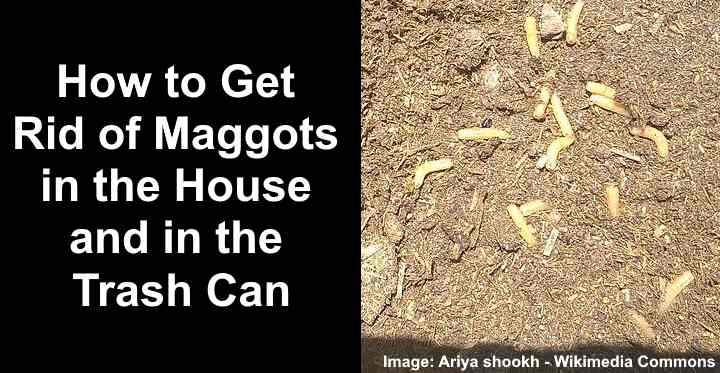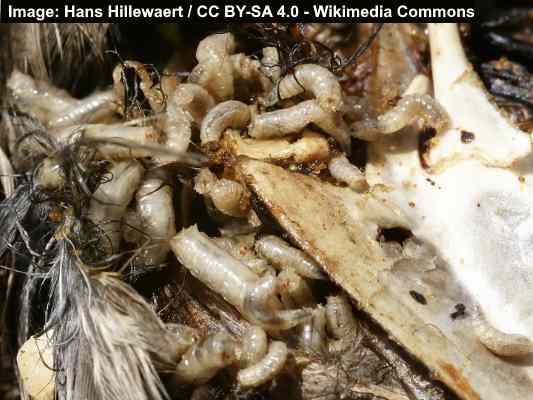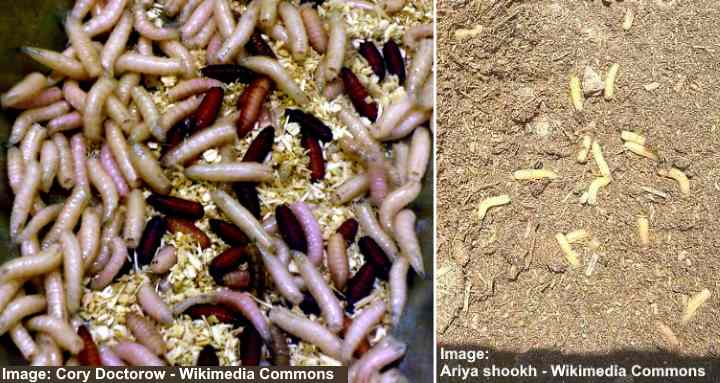How to Kill Maggots: 7 Ways To Get Rid of Maggots in the House and in Trash Can

Opening your trash can to find a horde of white, wriggling maggots can send you into a panic. The small worm-like creatures seem to come from nowhere and can quickly infest containers, garbage cans, under your sink, or other areas of your house. The best way to get rid of maggots is to prevent flies from laying eggs and kill the writhing larvae with boiling water or vinegar.
A maggot infestation in your home or trash cans is neither pleasant nor uncommon. Thankfully, there are some easy ways to eliminate maggots at the source and prevent them from returning. Although certain chemical insecticides can effectively kill maggots instantly, there are many natural methods for maggot control.
If you have found maggots crawling in your house or outside in the garbage cart, you’re probably wondering where they came from. Of course, you also want to know how to get rid of maggots fast. But, more importantly, how can you prevent maggots from ever returning?
This article is a guide to getting rid of maggots for good. You will also learn about the lifecycle of these disgusting writhing “grubs” to effectively control them.
What Are Maggots

Blowfly maggots
Maggots are fly larvae. After a housefly, blowfly, or any other type of fly lays an egg, a creamy-white colored worm-like creature emerges. There are many species of maggots, each with their own shape and characteristics. The grub-like larvae generally feed on waste and rotten food and even each other.
It’s good to note that the term “maggot” is not a scientific term. The white or brown wriggling creatures are the larval stage of flies in the order Diptera. However, maggot-like larvae can also be applied to the larval stage of any insect. For example, bees in their larval stage also look like maggots.
In this article, we will use the common term maggot when referring to the housefly, blowfly, or other common fly larvae that can infest trash cans or your home.
What Do Maggots Look Like

Maggots can be white, brown or gray depending on the fly species
Maggots are small, conical gray, white, or brown worm-like larvae. Maggots have a pointed head that they use to burrow into rotten food or waste. Small species of maggots look like a grain of rice. However, larger maggots may resemble a pale worm with a segmented body.
How Are Maggots Formed
Maggots grow and develop when they hatch from eggs. After a female fly lays eggs, it takes 24 hours for the larvae to hatch. The pale white grubs may only measure a few millimeters long. Like most larvae, maggots have a large appetite, and some species soon grow to be 0.8” (2 cm) long.
Where do Maggots Come From
Maggots come from eggs that female flies lay. Flies are attracted to rotten food, decaying or dead animals, feces, and trash. After a day, the larvae hatch and use their pointed head to bury into rotten organic material. After gorging on waste, the maggots can seem to appear from nowhere.
A female fly can lay up to 150 eggs a time and between 500 and 2,000 in her lifetime. The tiny eggs are difficult to spot, and maggots may be hard to detect after hatching.
So, it may not always be possible to tell where the maggots are coming from. However, suppose there are maggots in the house, and there’s rotting organic material lying around. In that case, the waste is a possible maggot source.
How Long do Maggots Live
Maggots live for three to five days, gorging on rotting fruit, meat, and other decaying materials. After the wriggling worms-like larvae mature, they enter the pupal stage, and after a week or so, the maggot will have turned into a fly. Then, if it’s a female fly, it will start laying hundreds of eggs which will hatch as maggots.
In the house, maggots commonly live in trash cans if you don’t empty them regularly. However, you can also get maggot infestation underneath carpeting or in sink drains. In that case, maggots seem to live indefinitely as flies lay eggs and hatch a day later.
What Do Maggots Turn Into?
Maggots turn into flies. If you don’t control maggots and flies, they can become a significant nuisance in your home. Although one maggot won’t become a major nuisance, fly larvae are not solitary grubs and typically appear in large numbers.
By examining the shape and behavior of maggots, you can tell what type of fly they will turn into. For example, narrow white larvae with strap-like plates on their back turn into drain flies. Creamy-white maggots with tapered heads turn into houseflies. Plumb yellowish-white maggots with rings around their body become blowflies.
What Do Maggots Eat?
Maggots feed on anything rotten. Flies usually lay eggs on rotten food, and maggots will start feeding there when they hatch. Rotten vegetables, meat, and fruits can feed hundreds of maggots for a few days. Maggots will also eat feces or the flesh of dead animals—in short, maggots eat anything.
What Kills Maggots
Maggots are typically easy to kill because they are soft-bodied insects. Boiling water is usually the fastest and most effective way to eradicate a mass or squirming white larvae. Alternative methods to get rid of maggots by killing them are using salt or pouring vinegar or lemon juice over them.
How to Kill Maggots in a Trash Can
To get rid of maggots from a trash can, first, empty the garbage receptacle of all trash and put it in a sealable bin liner. Then pour boiling water into the garbage can to kill white crawling grubs. If you have many maggots in the trash, you could allow birds to feast on the “juicy” worms.
How to Prevent Maggots
The easiest way to deal with a maggot infestation is to prevent them in the first place. For example, keeping flies away from your home, not leaving food out, and regularly disposing of trash helps prevent flies from laying eggs that turn into nasty white grubs.
By preventing flies from laying eggs, you can avoid the shock of seeing the disgusting white maggots crawling all over the inside of your wheelie bin after the garbage truck has collected the waste.
Here are some ways to prevent maggots from taking over your trash can:
Keep trash cans closed to prevent maggot infestation
The first step to prevent maggots is to prevent flies from getting into your trash. Ensure that trash can lids are always securely shut. Also, ensure that the trash cart can’t fall over and scatter rubbish everywhere. This maggot prevention method is necessary for the garbage can in your kitchen and your outside trash bin.
Don’t leave food out to avoid attracting maggots
Flies are attracted to meat, vegetables, or fruit that has started to go off. So, always ensure to store perishable food in sealable containers. To prevent food waste, it’s a good idea to keep perishable items in the refrigerator.
Also, be careful when leaving out cat or dog food as flies will lay eggs there, especially in hot weather. Then after a day, you may be shocked to see a mass of white grubs on your floor and wonder where the maggots came from.
Double wrap food waste when putting in the garbage can
Another way to prevent maggots in the trash can is to double wrap any food waste. Food that sits for a couple of days in the trash will quickly go rancid or start to decay. Flies will find a way into the garbage and could lay hundreds of eggs. Then before you know it, you’ve got maggots crawling out your trash can from seemingly nowhere.
Apart from sealing meat scraps and rotten fruit and vegetables, it’s vital to seal up any type of waste. This includes soiled diapers, pet waste, or anything else that attracts flies and gives maggots something to feed on.
Use bin liners for maggot prevention
It’s easy to keep maggots away from your property if you use trash cart liners. When the cart liners are full and ready for collection, you just have to tie the bag tight to seal any larvae that are lurking at the bottom of the cart.
So, if you seal garbage cart liners, you can remove all maggots instantly when it’s collection day.
Using trash cart liners for maggot prevention has another advantage. You rarely have to clean the inside of the garbage can. Waste that goes straight in the garbage cart sticks to the sides and builds up—creating the perfect environment for maggots to thrive.
Of course, it’s always a good idea to rinse out trash cans with hot, soapy water if you’ve had a problem with maggots. Then, all you need to do is turn the roll-away cart on its side, pour in hot, soapy water, and clean the sides and base with a brush. That way, you will kill all maggots and eggs instantly.
Empty trash cans regularly to keep maggots away
To prevent maggots in the home, regularly empty the trash can. In warm weather, you can seal the garbage bag every day or every other day and put it in the outdoor garbage cart. This means that you don’t give any fly eggs time to hatch and turn into maggots.
Keep garbage cans out of direct sunlight to prevent maggots
Flies are more active on warm, sunny days. So, keeping your outdoor trash can in a cool, shaded place can reduce the risk of maggots appearing in your yard or your trash can.
Use fly traps or fly tape to prevent flies from laying eggs
If maggots tend to be a problem in your area, then using flytraps or fly tape around the trash bin can help prevent maggots. But it’s good to remember that trapping flies this way is ineffective for maggot control if your bin is full of rotting food.
Keep your yard free of debris and pet feces
Flies will lay eggs on dog poop in your yard. Then seemingly from nowhere, you notice a crowd of maggots in your garden. So, to prevent maggots from becoming a nuisance around your property, bag and seal any animal waste in your garden.
How to Kill Maggots
Getting rid of maggots is not tricky. However, it takes some perseverance to kill off the revolting white larvae. Sometimes, you need two or three applications to eliminate maggots by killing the eggs and preventing flies.
Before taking action to eliminate white grubs from your trash can or home, it’s vital to understand where the larvae are coming from. If maggots are a problem in your home, thoroughly inspect areas where you keep food and clean any dirty areas.
Some homeowners report that maggots keep appearing despite repeatedly killing the repulsive white grubs. They discovered that maggots were living in rotting foundations of the home or that there was a bee infestation in the walls.
Let’s look in detail at how to get rid of maggots using non-chemical methods.
Get Rid of Maggots with Salt
Salt can be an effective way to get rid of maggots by killing them instantly. If you notice maggots crawling near your trash can, you can dump some salt onto them directly. Also, you can kill maggots lurking in the base of your trash bin by sprinkling a layer of salt after it’s been emptied.
Unfortunately, salt doesn’t kill maggot if you just dump it in your trash can. You will need to eliminate the maggots’ food source before taking action to kill the grubs.
Boiling Water Kills Maggots Fast
Boiling water is helpful for killing maggots to eliminate them on contact. For example, if you see maggots crawling around your bin, you can pour boiling water around the sides of the bin. Or, if you notice white grubs in your yard, the boiling liquid will instantly kill them when you pour it over them.
Boiling water has the advantage of being cheap and safe for the environment. This is a safer option than using a pesticide called permethrin to kill maggots in your home. But remember, you must be careful when handling boiling water.
Diatomaceous Earth Gets Rid of Maggots
A non-toxic way to kill maggots quickly is to sprinkle diatomaceous earth (DE) in your trash can. For example, suppose you notice maggots in your yard, and you don’t know where they come from. In that case, you could sprinkle DE over a wide area to try and kill the pests.
DE is an entirely safe pesticide that kills bugs by cutting their skin. The larvae then dehydrate and die and are not able to turn into flies.
It’s important to note that diatomaceous earth only works when it’s completely dry. So, for example, the inside can’t have any moisture for DE to work in your garbage can. Similarly, diatomaceous earth won’t kill maggots in the garden if it’s been raining or the ground is damp.
Use Vinegar to Kill Maggots for Good
Kill maggots and their eggs in a trash can by using a combination of vinegar and water. Mix equal parts of vinegar and water and pour on the maggots. Additionally, cleaning the inside of your rubbish cart with vinegar also helps disinfect it and get rid of bacteria. This way, you can help eliminate the odors and traces of rotten food that attract flies.
Kill Maggots in Drains with Vinegar and Baking Soda
Have you noticed flies coming out of your drains or maggots around your sink? If so, you need to kill the fly larvae and eggs that are lurking in your drain. One way to eradicate maggots from your home is to pour a mixture of vinegar and baking soda down the drain.
Combine a cup of baking soda and a cup of white vinegar. Pour the mixture slowly into the drain. Then run the faucet for a minute to flush the maggots and unhatched fly eggs away.
Eliminate Maggots from Home Carpets with Steam Cleaning
Maggots lurking in carpets can be a ghastly sight. However, there are two ways to get rid of maggots in carpets—boric acid and steam cleaning your carpet.
First, you can sprinkle boric acid over the carpet to kill the white larvae. Then sweep the carpet with a broom to disperse the boric acid. Finally, vacuum the carpet to remove all traces of maggots. After vacuuming, remove the dust bag, seal it in a plastic bag, and place it in the trash.
The second method to kill maggots in the home is to steam clean your carpets. Steam cleaning will also destroy any eggs that are lurking in the carpet fibers. If you discover that the maggots return, you will have to repeat the process.
Maggots in the home seem to come from nowhere. So if you see maggots in your carpet, it’s crucial to kill them quickly so that you can find the source.
Other Ways to Get Rid of Maggots
Natural methods are usually sufficient to get rid of maggots for good. However, some chemical methods may be faster and more effective—especially if the maggot infestation is severe.
You can use bleach to kill maggots and eggs that are infesting trash cans. Some people say that bleach’s strong odor also prevents flies from returning to disinfected areas for a while. However, it’s vital to remember that bleach is a toxic chemical and not environmentally friendly. If you decide to use bleach, always use protective gloves and goggles and clean trash cans in a well-ventilated area.
